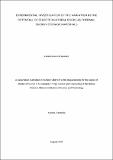| dc.description.abstract | Fossil fuels cause greenhouse gas emissions and are perceived to deplete, hence the use of
renewable energy is considered crucial. These renewables include the use of solar thermal
energy in concentrated solar power (CSP) generation and solar drying applications. However,
solar energy is intermittent, thus solved by incorporating thermal energy storage (TES) to store
heat energy for future use. However, the most common weaknesses in TES materials are high
cost of investment, environmentally unfriendly and are not locally available. Using natural
rocks is recommended as they are readily available, affordable and efficient TES materials for
solar drying applications at 40-75 °C and concentrated solar power generation at 500-600°C.
Despite its generational use in thermal applications, soapstone rock has not been studied as a
TES material. Moreover, site specificity has not been investigated in spite of being stated to
affect the potential of rocks in TES. Therefore, this study investigates the potential of soapstone
rock as a TES material, and the influence of the geological-tectonic settings. In the present
study, experimental characterization of selected natural rocks namely soapstone and granite,
was done to investigate their thermal properties at 20-950°C. Conclusively, soapstone rock
from the Craton geo-tectonic setting had the best properties and it had the highest young’s
modulus, thermal capacity, thermal conductivity and had a weight loss of only 0.75 % at 900°C.
At high temperatures, it did not show visible fracture. Moreover, soapstone and granite from
the Craton and Usagaran geo-tectonic settings exhibit significant differences | en_US |

